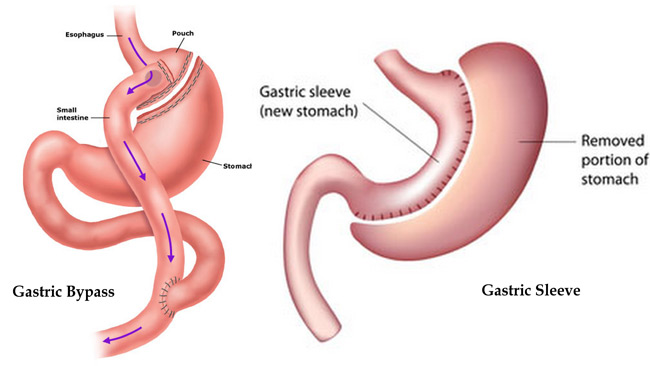Top 10 to Consider When Choosing a Surgical Weight-loss Option

Surgery may be an element of treatment for clinical severe obesity. A person is classified as being affected by severe obesity when their Body Mass (BMI) is greater than 40, or the body weight is more than 100 pounds over the ideal body weight. Additionally, individuals who have a BMI of 35 or greater with an existing co-severeity (i.e. diabetes, hypertension, etc.) are also classified as severely obese
There are four common types of weight-loss surgery, namely:
- Roux-en-Y gastric bypass
- Laparoscopic adjustable gastric banding
- Sleeve gastrectomy
- Duodenal switch with biliopancreatic diversion
There are certain aspects that need to be worked upon before choosing a surgical option.
 Desired Weight-loss
Desired Weight-loss
The choice of surgery depends greatly on amount of weight loss desired. In
general, gastric bypass patients will lose around 70 percent of their excess
weight, sleeve gastrectomy patients will lose around 60 percent, and gastric
banding patients will lose around 50 percent. Even though gastric banding
patients tend to lose less weight, they still see significant improvement in
their health and quality of life. The amount of excess weight
loss after
the biliopancreatic diversion (BPD) has been reported to be around 70 percent (
for patients with a higher BMI (BMI of 55 or more) - with weight loss in some
patients persisting up to 18 years. The
percentage of weight lost varies depending on the length of follow-up, the
quality of follow-up, the country where the procedure was performed, the
surgeon, and the initial weight of the patient.
 Reliability
of Weight-loss
Reliability
of Weight-loss
Gastric bypass and sleeve gastrectomy patients are able to achieve the
expected weight-loss via
surgery. What is important is the lifestyle adjustments required in the
first year after the weight-loss operation.
Weight-loss with adjustable gastric banding is much more variable. Some
patients lose 70-90 percent of their excess weight (remember, 50 percent
is expected), but some might lose almost no weight. With a band,
patients need to follow changes in lifestyle if they want to lose weight.
The good news is that when a gastric banding patient loses weight, they
almost always keep it off because they had to make lifestyle changes to
take off the weight and that is what keeps it off for ANY weight-loss
operation.

 Fast or Slow
Fast or Slow
Gastric bypass and sleeve patients will typically lose five to seven pounds a week early on and will reach their expected weight-loss 12-15 months after their operation. On the other hand, gastric banding patients tend to see a slower, steadier weight-loss (losing one to two pounds per week) but will see this continue until they reach their expected weight-loss around two years after their operation. More rapid weight loss is achieved by BPD and DS, as compared with gastric banding procedures.
 Fear of the Unknown
Fear of the Unknown
The long-term effects of gastric bypass and adjustable gastric banding appear that to be safe, and have lead to significant weight-loss and improvement in weight related medical problems, and most importantly, maintenance of the weight-loss. However this is not the case with sleeve gastrectomy at this point. Although the studies currently available show this operation to be safe and effective, but because the operation is new, we do not yet know- what is going to happen to patients 5 or 10 years after this operation. Will they see weight regain? Will there be problems due to removing so much stomach?
 Ability to Follow-up
Ability to Follow-up
In order to get an adjustable gastric band to be effective, it has
to be adjusted. In the first year after surgery, gastric banding
patients are typically seen more frequently than gastric bypass or
sleeve patients, so it is important that a gastric banding patient
be able to make these follow-up appointments in order to achieve
maximum weight-loss.
Before choosing gastric banding as an option work on the follow-up factor. If
your employer makes it very difficult for you to get to your doctor appointments
or if you live a great distance from your surgeon (more than 2 hours), you are
less likely to follow-up and therefore less likely to do well with your band.
Being a malabsorption operation, however, the BPD requires life-long medical
follow-up.
Long-term follow up and daily vitamin supplements are crucial to the success of
these operations. Life-long monitoring is necessary to prevent nutritional and
mineral deficiencies - just as with the RYGBP.

 Fear of Needles
Fear of Needles
In order to "fill" the band, a needle must be used. The needle is small and
fills do not really cause much pain, but if you are afraid of needles it does
not matter if the needle is small.
 Punishment Factor
Punishment Factor
Gastric bypass patients will very likely experience "dumping" if they eat foods containing sugars. After eating a sugary food, their heart starts racing, they start sweating and then they get severe abdominal pain, dizziness and oftentimes diarrhea. This really helps them stay away from those foods that may have caused them problems in the past. There is no dumping with gastric banding and sleeve patients so they need to be more disciplined in their food choices when it comes to sweets.
 Foreign Body Fear
Foreign Body Fear
Gastric band patients need to be comfortable with the fact that they have a band
in them which is to stay in their body for the rest of their life. The band is
not taken out when patient reaches a healthy weight.

 Reversibility
Reversibility
While it is true that taking out a band is pretty straightforward, there are few
reasons why a surgeon would remove a band. A gastric bypass is also reversible.
Certainly it is more challenging to reverse a bypass than it is to remove a
band, but it can be done.
A sleeve gastrectomy, however, cannot be reversed. If a band is removed or a bypass is reversed, a patient almost always begins regaining weight as they no longer have the "tool" that controlled their hunger and portion size.
The intestinal bypass portion of the BPD/DS surgery is partially reversible for those experiencing significant malnutrition issues.
 Fear Factor
Fear Factor
Many patients fear a gastric bypass or a sleeve gastrectomy because they feel it
is "more invasive" and therefore more dangerous. While it is true that a gastric
bypass and a sleeve gastrectomy are bigger operations, when we look at the
complication rates of all three operations, they are the same: 10-15 percent of
patients will experience a complication related to their operation at some
point. The disadvantage of transecting the duodenum( under Duodenal Switch) is
the large number of vital structures immediately adjacent to the duodenum.
Several large blood vessels and the major bile duct can be affected. Injury to
these structures can be life-threatening.
It is important to note that although weight-loss surgery has never been safer than it is today. But one needs to opt for an expert surgical opinion before going in for any option.
